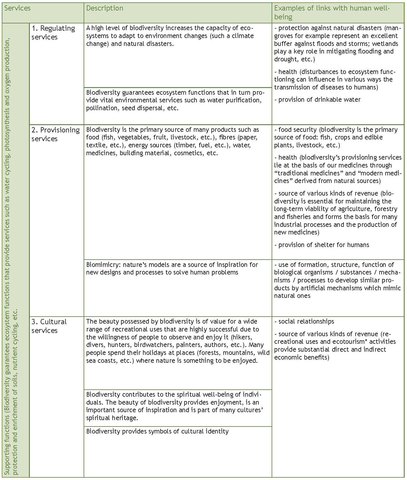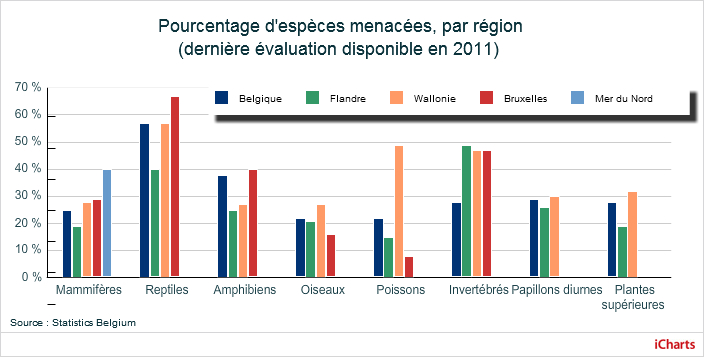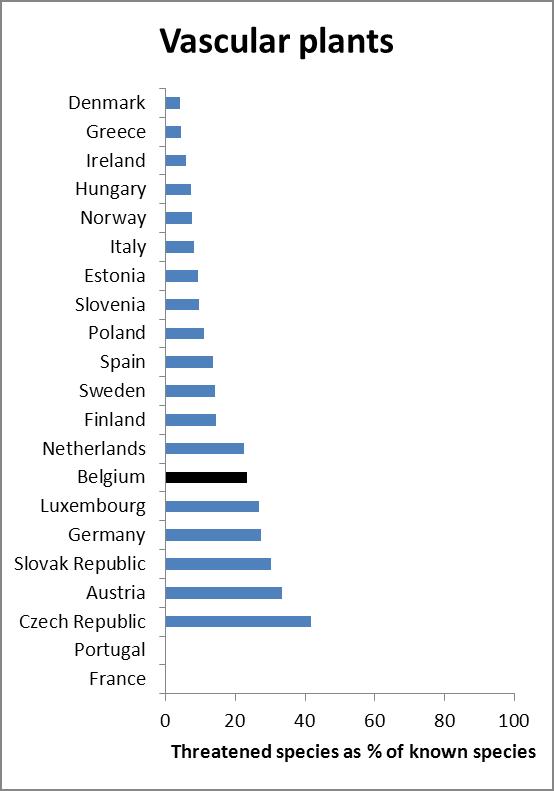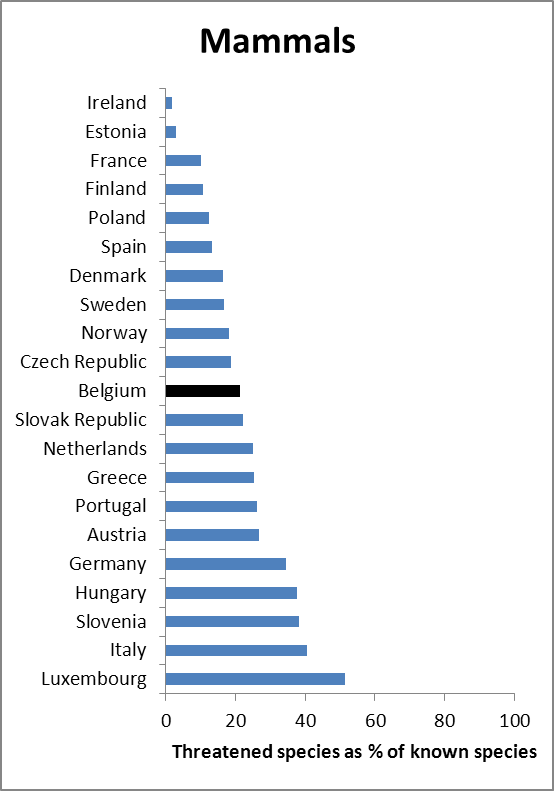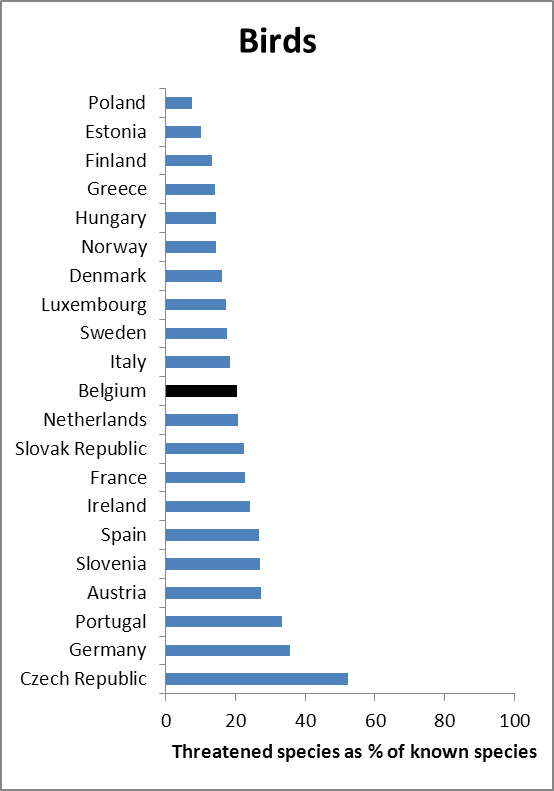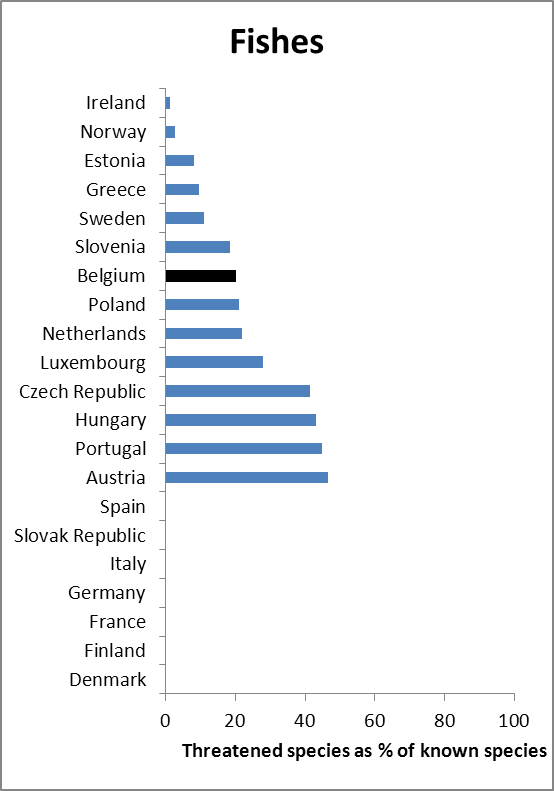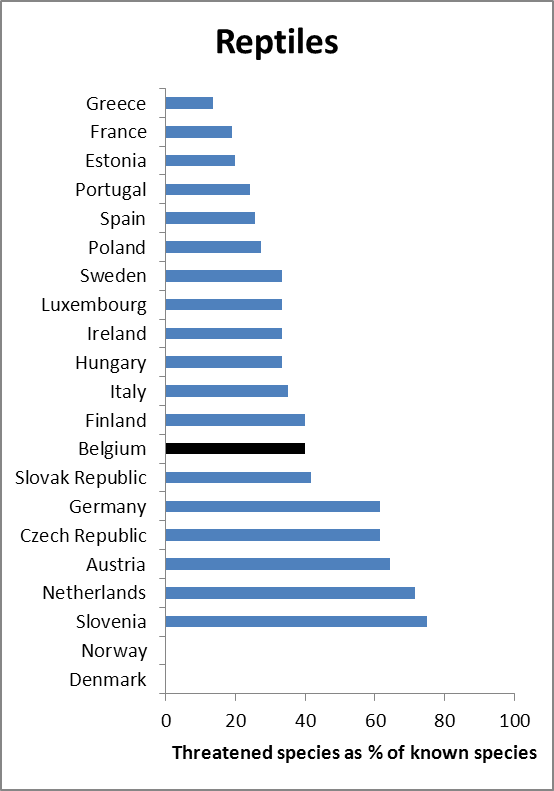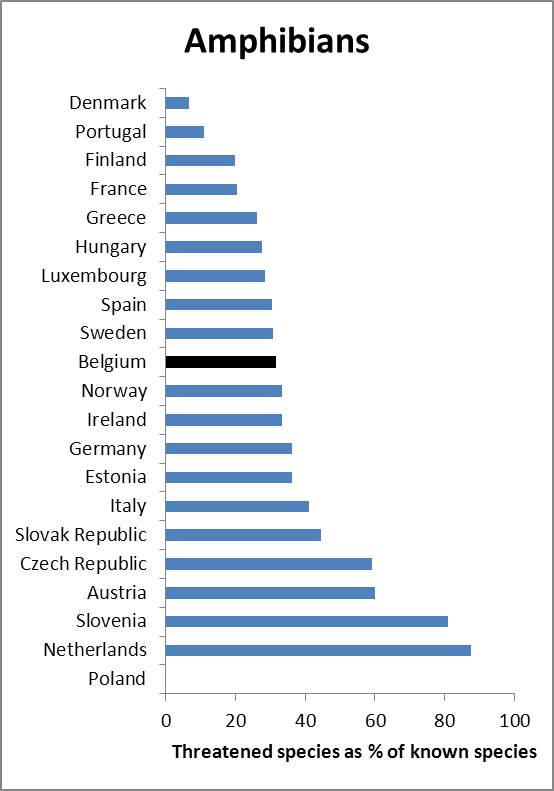| Mo | Tu | We | Th | Fr | Sa | Su |
|---|---|---|---|---|---|---|
| 1 | 2 | 3 | 4 | 5 | 6 | 7 |
| 8 | 9 | 10 | 11 | 12 | 13 | 14 |
| 15 | 16 | 17 | 18 | 19 | 20 | 21 |
| 22 | 23 | 24 | 25 | 26 | 27 | 28 |
| 29 | 30 |
 Part I: Introduction
Part I: Introduction
| Release date | 11/04/2014 |
|---|
I.1. Definition of biodiversity and ecosystem services
Biodiversity*[5], or biological diversity, is the variety of all life forms - plants, animals, fungi and micro-organisms, the genes* they contain, and the ecosystems* of which they are part. Humans are an integral part of biodiversity. Biodiversity is present throughout the whole biosphere, from a depth of 10,000 metres in the oceans up to the stratosphere. Biodiversity is continuously changing; it is the result of 3.8 billion years of evolutionary processes. Biodiversity is threatened by processes such as habitat destruction and fragmentation, pollution, overexploitation, spread of invasive alien species and climate change leading to population decline and species extinctions. Scientists estimate that the current extinction rate at global level is up to one thousand times higher than that seen in geological times and documented by the fossil records (Millennium Ecosystem Assessment, 2005).
For the purpose of this Strategy, the components of biodiversity are the following:
Ecosystems* - the variety of habitats, biotic communities and ecological processes. An ecosystem is defined by the dynamic interaction of species populations and the non-living environmental components that characterise the habitats. Ecosystems range from estuaries, rivers, ponds, marshes and temperate forests to tropical forests, coral reefs, mountains, deserts and others, including agricultural areas, urban parks and backyards. Ecosystem interactions include carbon cycle and other interactions, for example pollinators selecting flowers and predators consuming prey.
Species - the variety of species on Earth, from tiny organisms such as bacteria to much bigger life forms such as trees and whales. The estimated number of species living on Earth varies from 5 to 100 million. At present, about 1.9 million species have been named and described. Every year some 20,000 new species are described world-wide.
Genes - the variety of genetic information contained in all of the individual plants, animals, fungi and micro-organisms on Earth. Genetic diversity occurs within and between populations, as well as among species. Genetic variability is important to the survival of, in the first instance, populations and, ultimately, species as it is the key for populations to adapt to environmental changes and survive exposure to new diseases and parasites;
Ecosystem Services are the benefits people derive from ecosystems (Millennium Ecosystem Assessment, 2005). Different groups of ecosystem services can be distinguished (see Table 1): provisioning services, regulating services, cultural services, and the supporting services maintaining the conditions for life on Earth, like nutrient cycling and photosynthesis. Although ecosystems underpin all human life and activities, people are often not aware of the benefits they receive from nature nor of their value (see part I.2).
Biodiversity has many dimensions, the importance of which has still not been adequately addressed. It is imperative to complete the inventory of Belgium’s biodiversity and to improve the understanding of the role of biodiversity in ecosystem functioning. The gaps between existing knowledge and information needs for enhanced conservation policies can only be bridged by close cooperation between all the biodiversity partners in Belgium (see Appendix 1, Actors for biodiversity in Belgium).
Table 1. The different groups of ecosystem services.
I.2. Why does biodiversity matter?
Despite some progress since the 1970s, the worrying trends in the decline of biodiversity have not been reversed in Belgium, and there is therefore a need for a new impetus in order to meet the global and European target of halting biodiversity loss by 2020. This will involve a change in our lifestyle since most negative impacts on biodiversity result from human activities.
But why does biodiversity loss matter?
We have the ethical responsibility to preserve biodiversity for its intrinsic values: species have a value “in and of themselves” as the result of the evolution of life on earth.
The current extinction rate of biodiversity also poses a direct threat to human well-being, since biodiversity plays a vital role as a provider of products and services that make life on Earth possible, and furthermore satisfies the needs of human society. The table below summarises some major services provided by biodiversity (based on the Millennium Ecosystem Assessment, 2005). However, arguments to protect biodiversity cannot be limited to what biodiversity can do for humans.
The full costs of loss and/or degradation of biodiversity are difficult to gauge, but available evidence demonstrates that they are substantial and growing. We can rarely value biodiversity itself directly; we value services of the ecosystems of which biodiversity forms an integral and essential part. However, as many of the ecosystem services and benefits are freely available, they are not reflected in standard economic measurements. Moreover, we do not know exactly how many species exist or how many are disappearing. Also many ecosystem services cannot be replaced or if they can, it is only at considerable cost.
The Economics of Ecosystems and Biodiversity (TEEB, 2010[6]) study is a major international initiative to draw attention to the economic benefits of biodiversity, to highlight the growing costs of biodiversity loss and ecosystem degradation, and to draw together expertise from the fields of science, economics and policy (see more information under objective 7). According to the report, at least 40 per cent of the world’s economy and 80 per cent of the needs of the poor are derived from biological resources. In addition, the richer the diversity of life, the greater the opportunity for medical discoveries, economic development, and adaptive responses to such new challenges as climate change. These estimates give an essential insight into biodiversity’s real value. Further analysis and discussion in this field will certainly help countries improve their economic and environmental decision-making processes.
I.3. Current status of biodiversity in Belgium
Habitats
Belgium has a surface area of 30,528 km² on land and territorial waters in the North Sea of 3,462 km². Yet for such a small territory, it has a remarkable diversity of habitats and species. Flanders, Brussels and North of Wallonia belong to the Atlantic region. The region south to the river valleys of the Meuse and Sambre belong to the Continental region while the marine waters are part of the East Atlantic Boreal biogeographic zone. The main vegetation types found in Belgium are deciduous and coniferous forests, grasslands, heathlands, peat bogs, wetlands, lakes and rivers, and marine ecosystems in the North Sea. The distribution of these varies from region to region. For example, about 80 % of the forested areas are found in the southern part of the country. On the other hand, northern Belgium is noted for its semi-natural grasslands, wetlands, heathlands and coastal dunes.
The geographical and geological characteristics of Belgium (high plateaus of the Ardennes in the south, the extensive river valleys of the Meuse and Scheldt and the fertile loamy areas in the centre and the low-lying polders on the coast) together with the long-standing human impact in the area of land use have resulted in a huge diversity of natural to semi-natural habitats, many of which are of European importance. At present, no fewer than 58 of them are listed in the EU Habitats Directive and are protected as part of the Natura 2000 network. The Natura 2000 network currently covers up to 12.77 % of Belgian territory at land and 35.85 % at sea).The trends in habitats have been evaluated within the framework of the Article 17 reporting of the EU Habitats Directive (2008-2013)[7]. The overall assessment of conservation status is the following: 9 % of the Belgian habitats of European interest have a favourable conservation status*; 17% have an inadequate, 73 % a bad and 1 % an unknown status.
Species
The Belgian diversity of life forms is made up of around 36,300 recorded species of micro-organisms, plants, fungi and animals. However, expert extrapolations suggest that the actual number should range between 52.000 and 55.000 species. Bacteria and blue-green algae are not included in these numbers. Roughly 6.000 species of bacteria are known worldwide, but this is deemed to be only a fraction of the real number. As many bacteria species are cosmopolitan, we assume that at least a few thousand of them are present in Belgium. In addition, some 300 species of blue-green algae have been found in Belgium, and many more are expected to be discovered. Hence, the total number of species living in Belgium probably amounts to over 55,000 species (Peeters et al., 2003). This figure exceeds all previous estimates and indicates that at present less than two thirds of the species living in our country have been recorded. Moreover, our knowledge is unbalanced and less than 4 % of the species living in Belgium have been studied in detail. The best known are the vascular plants (flowering plants, conifers, ferns, horsetails, quillworts and clubmosses), bryophytes, macro-algae and macro-lichens, vertebrates (fish, amphibians, reptiles, birds and mammals), carabids (ground beetles), butterflies, and dragon and damselflies. They are often used to underpin and justify conservation measures and many species are well-known bio-indicators. Obviously, expanding our knowledge of the remaining 96 % of organisms would improve, refine and optimise Belgian conservation policies and actions.
Detailed monitoring and thorough comparisons of old collection and observation data with more recent ones show that many species in Belgium are in decline or have indeed already vanished from our country. It can be estimated that roughly between 20 % and 70 % of the species per main group of organism are threatened, depending on the group and the region of the country. The trends in the species listed in the EU Habitats Directive have been evaluated within the framework of the Article 17 reporting of the Habitats Directive for the period 2008-2013[8]. The overall results for the species of European interest show that 43 % have a bad conservation status, 26 % an inadequate status and 19 % a favourable status. For 12 % of the habitat types there is not enough information.
Although biodiversity offers a broad range of goods and services, human activities are the main reasons for its loss. A third of plant and animal species in Belgium are under threat. Today, dozens of plant and animal species in our country are only known from less than five populations and are therefore in critical danger. Many hundreds, probably thousands, of species are at risk in Belgium (Peeters et al., 2003; Dumortier et al., 2005; CEEW, 2005).
The most important processes that threaten the country’s biodiversity are briefly described in the next section. The pressures on biodiversity are similar throughout the country, although they vary in intensity between the Regions.
For a comprehensive panorama of the status and trends of biodiversity in Belgium (including prokaryotic, fungal, botanical and zoological diversity) we refer you to the book “Biodiversity in Belgium, a country study” (Peeters et al., 2003[9]), which also addresses the most important and protected ecosystems in our country. More detailed and more precise information is available for each region of Belgium and the North Sea. For all of them, nature and environment reports are compiled using European headline biodiversity indicators. The Environmental Outlook for Wallonia 2010[10] and the “Key environmental indicators for Wallonia in 2012”[11], the “Rapport Nature 2012”[12] (Nature Report of the Brussels-Capital Region) and the “Natuurrapport”[13] (“Nature Report”, abbreviated NARA 2009, Dumortier et al., 2009) provide up-to-date data for the three regions.
Figure 2. Species status in Belgium, Flanders, Wallonia, Brussels and the Belgian part of the North Sea in 2011. (Source: Statistics Belgium - http://statbel.fgov.be/fr/statistiques/chiffres/environnement/diversite_biologique/).
Genetic diversity and ex situ conservation*
No comprehensive overview of genetic resources in Belgium has been conducted so far and ever more data are becoming available with the setting up of new research programmes in the area of cryobanks* and ex situ collections. The status of conservation of genetic diversity of crops and livestock, and that of harvested species of trees, fishes, micro-organisms and wildlife are addressed by different programmes in Belgium. Our zoos, botanic gardens and universities coordinate or participate in several international programmes for ex situ conservation, such as breeding programmes that aim at the reintroduction of endangered species worldwide. An overview of these programmes and the species involved is available in the Third National Report to the CBD (Peeters, 2005). A first report on animal genetic resources was submitted to the FAO in 2004 within the framework of the first State of the World’s Animal Genetic Resources (Massart, 2004).
I.4. Threats to biodiversity
Although we depend on biodiversity for our survival and well-being, causes of biodiversity loss are mostly human-induced, arising as a secondary result of activities in sectors such as agriculture, forestry, fisheries, water supply, transportation, urban development, tourism, or energy. Combinations of these activities generate processes that threaten biodiversity, such as habitat destruction and fragmentation, pollution, overexploitation, the spread of invasive alien species, physical pollution by chemicals or through noise perturbation, the longer term changes to climate that result from various atmospheric emissions, etc. Figure 2 illustrates percentages of species threatened in 8 important classes.
The threats described below are not listed in order of importance. All these processes cause significant damage to biodiversity and their effects are cumulative.
Land conversion, whether for urban, industrial, agricultural, transport or tourism purposes, is undoubtedly the main cause of biodiversity loss in Belgium. It results in the destruction, degradation and fragmentation of all habitat types.
Pollution, reducing the quality of the environment and leading to phenomena such as eutrophication, acidification, soil degradation, and noise perturbation, is considered as the second main threat to biodiversity in our country. In Flanders, Brussels and the marine area, changes in environmental quality due to eutrophication put serious pressure on the fauna and flora. This problem is probably less acute in Wallonia, but pollution (including eutrophication) is nevertheless considered to be the second threat to biodiversity in the Region.
The direct and indirect overexploitation (i.e. over-use or over-harvesting mainly for food) of natural resources leads to population decline and species extinction. Groundwater pumping leads to desiccation of wetlands and disappearance of related fauna and flora. Over-fishing of commercial fish stocks (cod, sole and plaice) is a sad reality in the North Sea. The fishing activities also lead to bycatches, putting a heavy pressure on other species not intentionally fished such as the harbour porpoise. Sea-bottom habitats and their biodiversity are under severe pressure from beam trawling, the most common fishing practice in Belgian marine waters. Overall fishing activities have resulted in a sharp decline in long-living and slowly reproducing species such as rays and sharks and many habitat-structuring species like oysters and other large invertebrates.
The increasing number of invasive alien species is an important threat in Belgium. In the Belgian coastal waters, invasive alien species constitute a predominant proportion of the marine fauna. They compete with native species, change the original habitat and significantly alter the overall composition and abundance of species. Brussels is a major entry point for alien species due to the concentration of transport activities and contact possibilities. Besides their out-competing potential, invasive alien species can also have an impact on agriculture, economy and public health.
Climate change is not only at the origin of outbreaks of some invasive alien species, pests and diseases, but it also constitutes a direct threat to biodiversity by disrupting ecological relations, unbalancing ecosystem functioning, causing disturbance to the lifecycle of some species (birds among others), and the migration of species. The presence and number of warm-temperate species have been increasing over the past decades, including in the North Sea (among others zooplankton, insects, spiders, fish, birds). New Southern dragonfly species were among the first reported to breed in Belgium. The survival of different bird species wintering in Europe has increased. The positive effects of temperature increase on vegetation growth (growing season has increased by 10 days between 1962 and 1995) are projected to be counteracted by an increased risk of water shortage which would adversely affect vegetation (EEA, 2004).
Public authorities and Belgian household consumption and production patterns have a significant impact on the environment and on biodiversity. Our current way of life, consumption and production patterns centred on growth and competitiveness exert major pressures on biodiversity. It is crucial to evolve towards sustainable production, consumption, products and services, land use and mobility patterns.
Other causes of pressure on biodiversity are the growing recreational pressure on green areas (mainly in Brussels) and the extraction of sand and gravel in our marine waters and some river systems. Some threats are methodological or institutional, such as the lack of ecological and taxonomical knowledge on various aspects of biodiversity, and the fragmentation of competences in Belgium hampering early action and coordinated initiatives.
Biodiversity is not distributed evenly on earth. Belgium mainly has an impact on biodiversity abroad, either indirectly through the pollution originating from our country, or directly through its importations or projects and development supported or generated by Belgian private or public actors abroad, for example various industrial players and tourism.
Figure 3. Percentages of threatened species in Belgium and other European countries among vascular plants, mammals, birds, fish, amphibians and reptiles (source: OECD (2012), "Threatened species", OECD Environment Statistics (database). doi: 10.1787/data-00605-en (Accessed on 23 September 2013)[14].
[5] Terms followed by an asterisk are defined in the glossary
[7] See also http://cdr.eionet.europa.eu/be/eu/art17/envucdy2q
[8] See also: http://cdr.eionet.europa.eu/be/eu/art17/envucdy2q
[9] An executive summary of this book is available online in French and Dutch:
“La biodiversité en Belgique: un apercu” / “Biodiversiteit in België: een overzicht” (Peeters et al., 2013). http://www.sciencesnaturelles.be/institute/structure/biodiv/biodiversity/treasures/pdf/bibke_fr.pdf (in French), http://www.natuurwetenschappen.be/institute/structure/biodiv/biodiversity/treasures/pdf/bibke_nl.pdf (in Dutch)
[10] See: http://etat.environnement.wallonie.be/index.php?page=environmental-outlook-2010
[11] See: http://etat.environnement.wallonie.be/index.php?page=key-environmental-indicators-for-wallonia-2012
[12]See: http://documentation.bruxellesenvironnement.be/documents/NARABRU_20120910_FR_150dpi.pdf (in French) and http://documentatie.leefmilieubrussel.be/documents/NARABRU_20121004_NL_150dpi.PDF (in Flemish).
[13] See: http://www.inbo.be/files/bibliotheek/26/185826.pdf
 This site uses cookies in order to function as expected. By continuing, you are agreeing to our
This site uses cookies in order to function as expected. By continuing, you are agreeing to our 
